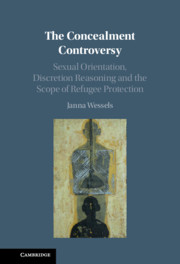 The Concealment Controversy
The Concealment Controversy Book contents
- The Concealment Controversy
- The Concealment Controversy
- Copyright page
- Contents
- Figures
- Tables
- Acknowledgements
- 1 The Concealment Controversy
- 2 Unpacking the Controversy
- Part I Tracing ‘Discretion’ Reasoning
- Part I Conclusions
- Part II Exploring the Limits of Protection
- Conclusion
- Annex
- Bibliography
- Index
Part II - Exploring the Limits of Protection
Published online by Cambridge University Press: 19 July 2021
- The Concealment Controversy
- The Concealment Controversy
- Copyright page
- Contents
- Figures
- Tables
- Acknowledgements
- 1 The Concealment Controversy
- 2 Unpacking the Controversy
- Part I Tracing ‘Discretion’ Reasoning
- Part I Conclusions
- Part II Exploring the Limits of Protection
- Conclusion
- Annex
- Bibliography
- Index
Summary
Part I explored decision-making practice concerning sexuality-based asylum claims in France, Germany and Spain. The different countries’ jurisprudence revealed that ‘discretion’ reasoning was prevalent in all three jurisdictions, and remained resistant to challenges over time, albeit with significant differences in focus. France, for example, granted protection only to those who had manifested their sexual orientation, whereas Germany limited protection to those with a determined identity. Either act or identity can stand in for the group, while the respective counterpart can be assessed as part of another aspect of the Convention definition. The fact that it is sometimes the act that counts for the Convention ground, and other times the identity, makes the reasoning more difficult to reconstruct.
- Type
- Chapter
- Information
- The Concealment ControversySexual Orientation, Discretion Reasoning and the Scope of Refugee Protection, pp. 169 - 230Publisher: Cambridge University PressPrint publication year: 2021
